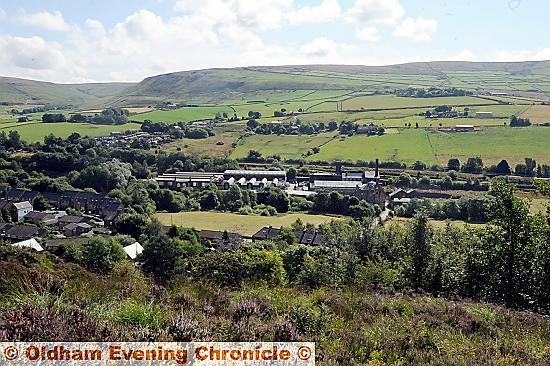New school site under spotlight
Reporter: Iram Ramzan
Date published: 25 January 2017
COUNCILLORS were "inadvertently being misled" on the best site location for the new Saddleworth School, a court heard yesterday.
This was one of several claims made during a full judicial review into the building of the £19.2million secondary school, which has sharply divided public opinion in Diggle and the wider Saddleworth area. Planning permission was granted for the school in Diggle at the former WH Shaw Pallet Works site, with capacity for 1,500 pupils.
Construction at the new school was originally set to begin in Easter, 2014, with the new school set to open in autumn, 2015. Oldham Council and Saddleworth School are working in partnership, with the Education Funding Agency (EFA) managing the project for the Department for Education.
Four applications were made to the council, seeking approval for demolition of the industrial buildings on the site, demolition of the listed link bridge, construction of the school and the associated facilities, and for a parental drop-off area. The latter, however, was rejected on grounds of highway safety and lack of parking.
However, all four applications had been recommended for refusal by the Saddleworth Parish Council's conservation areas advisory committee.
Campaigners from Save Diggle Action Group (SDAG) took their case to the Royal Courts of Justice in London last September.
They submitted that planning officers had overlooked some important provisions of the National Planning Policy Framework and were granted a judicial review hearing against Oldham Council, which took place at Manchester Civil Justice Centre yesterday.
If SDAG are successful, the legal challenge could result in the planning permissions being quashed.
SDAG say they have never been against the building of a new school, but that it can and should be built on the current site in Uppermill.
The group said more than 3,300 people signed a petition calling for the school to remain in Uppermill.
In June, however, another group of parents and local residents launched the D4SS - Diggle for Saddleworth School - website working in support of the "expedient development" of the new school in Diggle.
Robert McCracken QC, representing SDAG in court yesterday, said the case was an example of the impact public participation can have.
He made several points on the group's behalf, which included contention over four possible site locations, impact on cultural heritage and the Greenbelt, and information not being made available for the public in time.
He told Mr Justice Timothy Kerr: "This case has illustrated the value of public participation.
"We're all agreed there should be a new school - that is not the issue.
"There's much opposition to the transfer of the school from the centre of the community to the outskirts of Diggle.
"Until February, 2016, the council took the view that that the impact on cultural heritage wouldn't be substantial.
"The Education Funding Authority agreed to the principle of funding in place for a school.
"All four site options were viable alternatives - none had been ruled out for any reason
"The new site has a weaker relationship to the community."
Mr McCracken also said that councillors were under the impression that other sites were not viable and that EFA funding was fixed.
This, he stated, was incorrect and that a meeting with Mike Green, from the EFA, can in fact give additional funding of up to £5m more for "abnormal" costs, therefore all four site options were within EFA's budget for the school.
He added: "Councillors were inadvertently being misled on the true position. They were told you can't consider the Uppermill site. The reports were often unclear and inconsistent."
Cultural heritage is deemed to be another contentious issue for SDAG and other campaigners. Mr McCracken said councillors were told that the current non-listed buildings on the Diggle site were not economically viable, hence why that site was selected.
This, he said, was a result of them not being marketed properly - if they had been, he said, they could have been bought by a developer who may have transformed them in keeping in-line with the area.
"The planning officer's original report in February, 2016, says that harms to listed building were deemed 'less than substantial'", Mr McCracken said.
"The buildings hadn't been marketed properly and it was suggested that they were not economically viable. They were not being marketed properly to be brought back into use."
The council since conceded that the original comment about the effect on the cultural heritage was incorrect.
A grade II-listed clock tower will remain intact on the site but the rest of the non-listed buildings, off Huddersfield Road, will be demolished.
Concerns were also raised about flooding in fields next to the proposed school - currently earmarked for grass pitches - citing the Boxing Day floods in 2015.
The national advisory Sports England, which was asked to consult on the plans, previously described them as "not fit for purpose".
Another claim made on behalf of SDAG was that the public consultation was "defective", as the public did not have sufficient documents nor the access to such documents that should have fully briefed people about the application.
"There are fundamental defects," Mr McCracken added. "The decisions can't stand."
Oldham Council was due to respond to these points when the hearing resumed today.
Most Viewed News Stories
- 1Head confident that Saddleworth School is still 'heading in the right direction' despite 'Requires...
- 2Two Oldham students study at both Oxford AND Cambridge
- 3Saddleworth will steam to success again this year
- 4No trams to run between Oldham and Rochdale on Sunday
- 5Taxi rank to close as ‘major works’ take place in Oldham town centre





